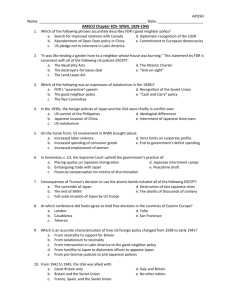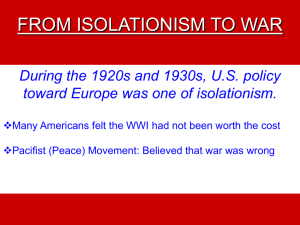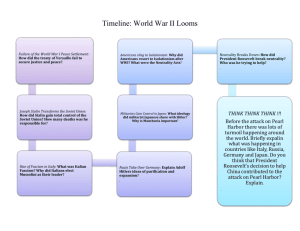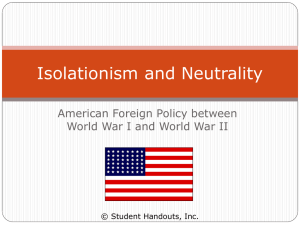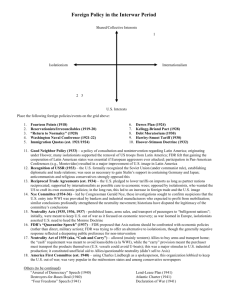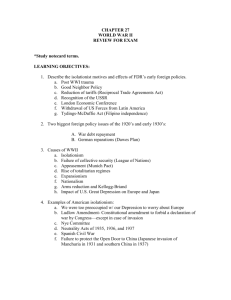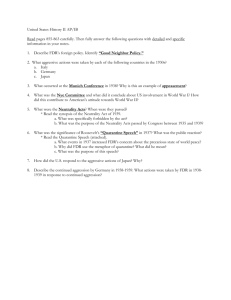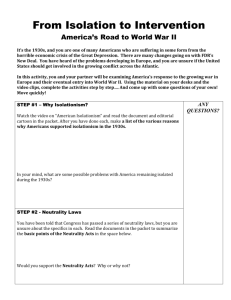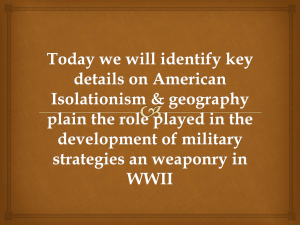United States Isolationism to War WWII
advertisement
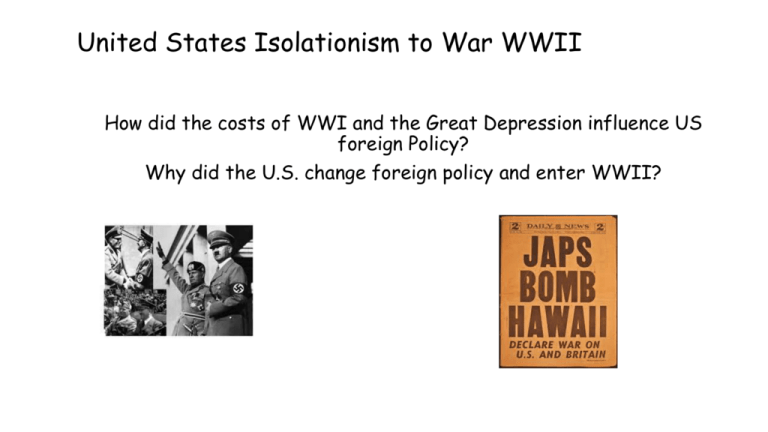
United States Isolationism to War WWII How did the costs of WWI and the Great Depression influence US foreign Policy? Why did the U.S. change foreign policy and enter WWII? What is isolationism? Definition of Isolationism 1. Neutral with no trade 2. No permanent, entangling alliances 3. Keep U.S. sovereign, free, at peace 4. Emphasis on legalism, not force - a "law-bound" world of Great Powers keeping order Why did the US take a policy of isolationism after WWI? • U.S casualties: 125,000 troops wounded and 53,000 killed • Why a factor? • $10 million was lent to the Allies at high rates of interest. • European nations cannot pay back – Why? • Nye Committee – belief US fought in WWI to gain profits for munitions industry • Influences support for American Neutrality • Dislike of ‘Old World’ • Dangerous Ideas – fascism & communism Consequences of Isolationism 1. U.S. does not join the League of Nations – organisation set up by the Treaty of Versailles to keep peace in the future. 2. Restrictions on immigration set in 1921: • Quota systems and set number of immigrants allowed 3. High tariffs (taxes) on products from other countries. Why does U.S. take neutral stance in foreign policy? Neutrality – Neutral with trade Nation’s foreign policy calls for not taking sides in any international argument, controversy, dispute, or war International trade is okay, so long as it does not involve picking sides in a dispute Neutrality Acts (1935, 1936, 1937) permitted only “cash and carry” sales, with no loans or weapons sales, to nations at war Wants no more entangling alliances Neutrality Acts: 1935, 1936, 1937 When the President proclaimed the existence of a foreign war, certain restrictions would automatically go into effect: Prohibited sales of arms to belligerent nations. Prohibited loans and credits to belligerent nations. Forbade Americans to travel on vessels of nations at war [in contrast to WW I]. Non-military goods must be purchased on a “cash-and-carry” basis pay when goods are picked up. 1939 Neutrality Act • In response to Germany’s invasion of Poland. • FDR persuades Congress in special session to allow the US to aid European democracies in a limited way: The US could sell weapons to the European democracies on a “cash-and-carry” basis. FDR was authorized to proclaim danger zones which US ships and citizens could not enter. • Results of the 1939 Neutrality Act: Aggressors could not send ships to buy US munitions. The US economy improved as European demands for war goods helped bring the country out of the 1937-38 recession. • America becomes the “Arsenal of Democracy.” End of US Neutrality – Lend Lease Act March, 1941 • Lend-Lease Act: “An Act to Promote the Defense of the United States” • allowed U.S. to sell, lend or give war materials to nations the U.S. wanted to support • U.S. gave $50 billion ($650 billion today) to Allied nations during war U.S. Embargos on Japan • 1937 – 1941 escalating conflict between China and Japan influences US relations • Two events sway US public opinion: • Japanese actions in capital of Nanjing • Japanese bomb U.S.S. Panay as it was evacuating American citizens from Nanjing • U.S. will continue to increase aid via Lend Lease to China • Japan takes territory in French Indo-China • U.S. halts negotiations, increases extent embargo cutting off war supplies and freezes Japanese assets in U.S. banks Why does U.S. change policy and enter WWII • German and Italian aggression in Europe • Germans start attacking U.S. merchant ships • Growth of fascism – belief in everything exists for the state and government controlled by a dictator • Japanese aggression in Asia plus: • Threaten Philippines a U.S. protectorate • Joins Italy and Germany to create the Axis • U.S. places embargo on Japan leading them to attack U.S Enters WWII • Pearl Harbor, December 7, 1941 • Japanese attack on U.S. naval base at Pearl Harbor • FDR (Franklin Delano Roosevelt) “A date that will live in infamy!”
